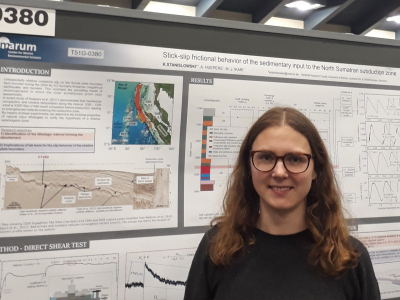- Graduate School GLOMAR
- PhD student reports
- Conference Reports
- Conference Reports 2019
- Katja Stanislowski
Katja Stanislowski
Report of GLOMAR PhD student Katja Stanislowski about her participation in the Fall meeting of the American Geophysical Union (AGU) in San Francisco, USA from 9 to 14 December 2020
Attending the American Geophysical Union (AGU) Fall Meeting, the largest earth and space science conference in the world, was a remarkable experience on many different levels. From 9 to 13 December 2019, around 30,000 scientists came to San Francisco, California, presenting their work and celebrating AGU’s Centennial.
The focus of my research is to study the velocity- and time dependent frictional behavior of natural input material to subduction zones playing a key role in understanding the occurrence of potentially hazardous unstable slip on the fault systems. Covering the research fields of tectonophysis, structural geology, physical properties of rocks, seismology, and natural hazards, 2019’s program of the AGU Fall Meeting offered a variety of interesting sessions relevant to my research, especially those on brittle deformation and fault-related processes. In the form of a poster, I presented our study on “stick-slip frictional behavior of the sedimentary input to the North Sumatran subduction zone” in the well matching session “Interplay between structure, fluids, and deformation processes at subduction zones”. This session delivered valuable insights to the most up-to-date work in earthquake research illuminated by leading researchers in the field. During the highly attended subsequent poster session, I had very fruitful discussions not only about our presented work providing me with useful feedback and new perspectives for my ongoing research, but also about possible collaborations. Beside the poster sessions, also the annual Physical Properties of Earth Materials group dinner and the IODP townhall meeting were perfect opportunities to network and meet fellow science party members of IODP cruise 358 again.
Along with the conference itself, also its location provided a great opportunity for me to yet again grasp the impact of seismic fault activity on densely populated areas and therefore the importance of earthquake research. Prior to the conference, I attended a field trip where we were introduced to spectacular geomorphologic evidence of the slip history of the active San Andreas Fault system around the bay area. After the conference, we went on our own to see impressive proof of seismic slip in the Corona Heights Park, the source of various studies on earthquake faulting, in the middle of San Francisco.
In summary, I greatly benefitted from attending the AGU Fall Meeting 2019. I got a very good overview of current research, received input for my own work, and strengthened and expanded my network in the scientific community of my field of research. I therefore kindly thank GLOMAR for the financial support to attend this impressive conference.



